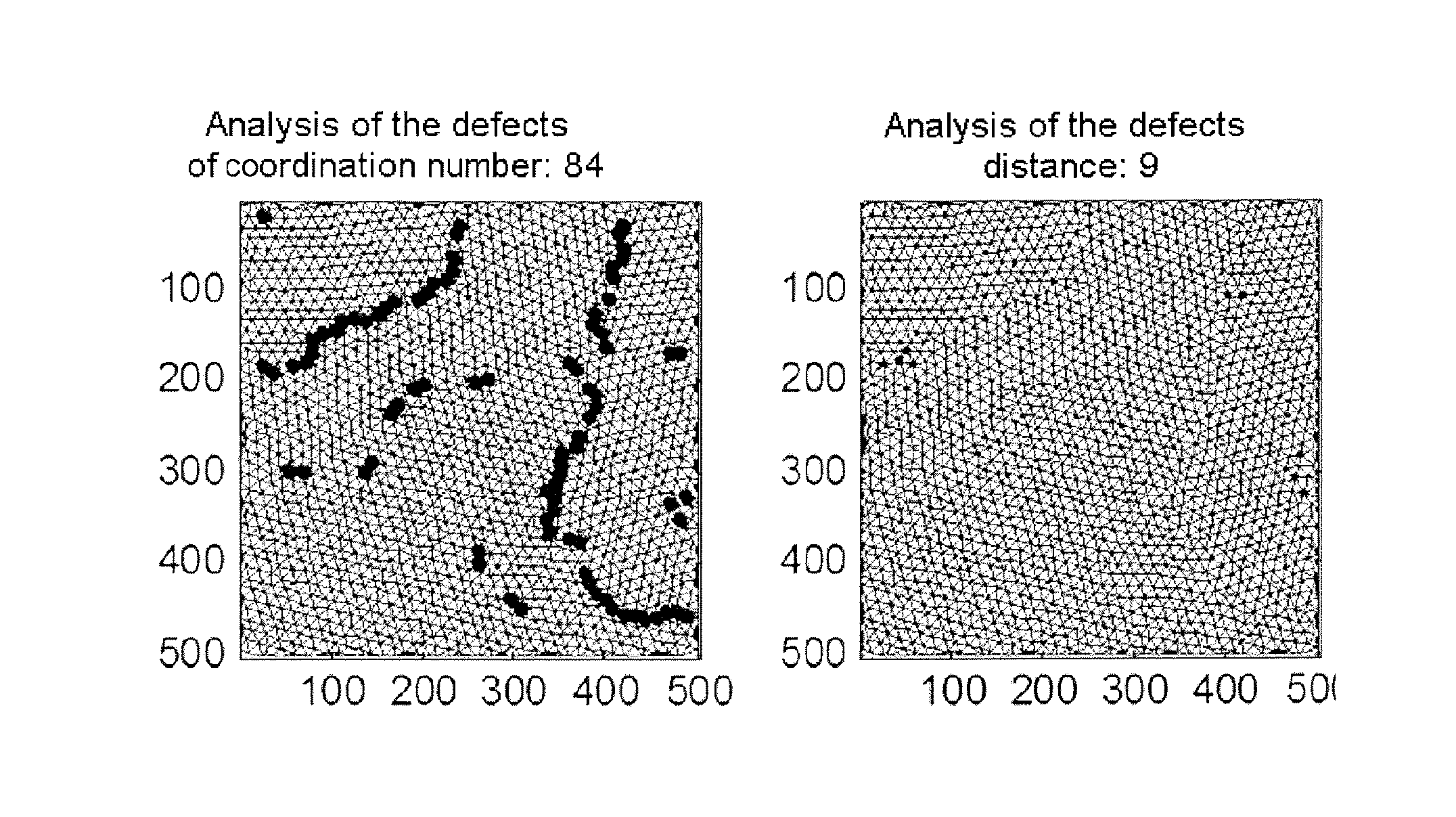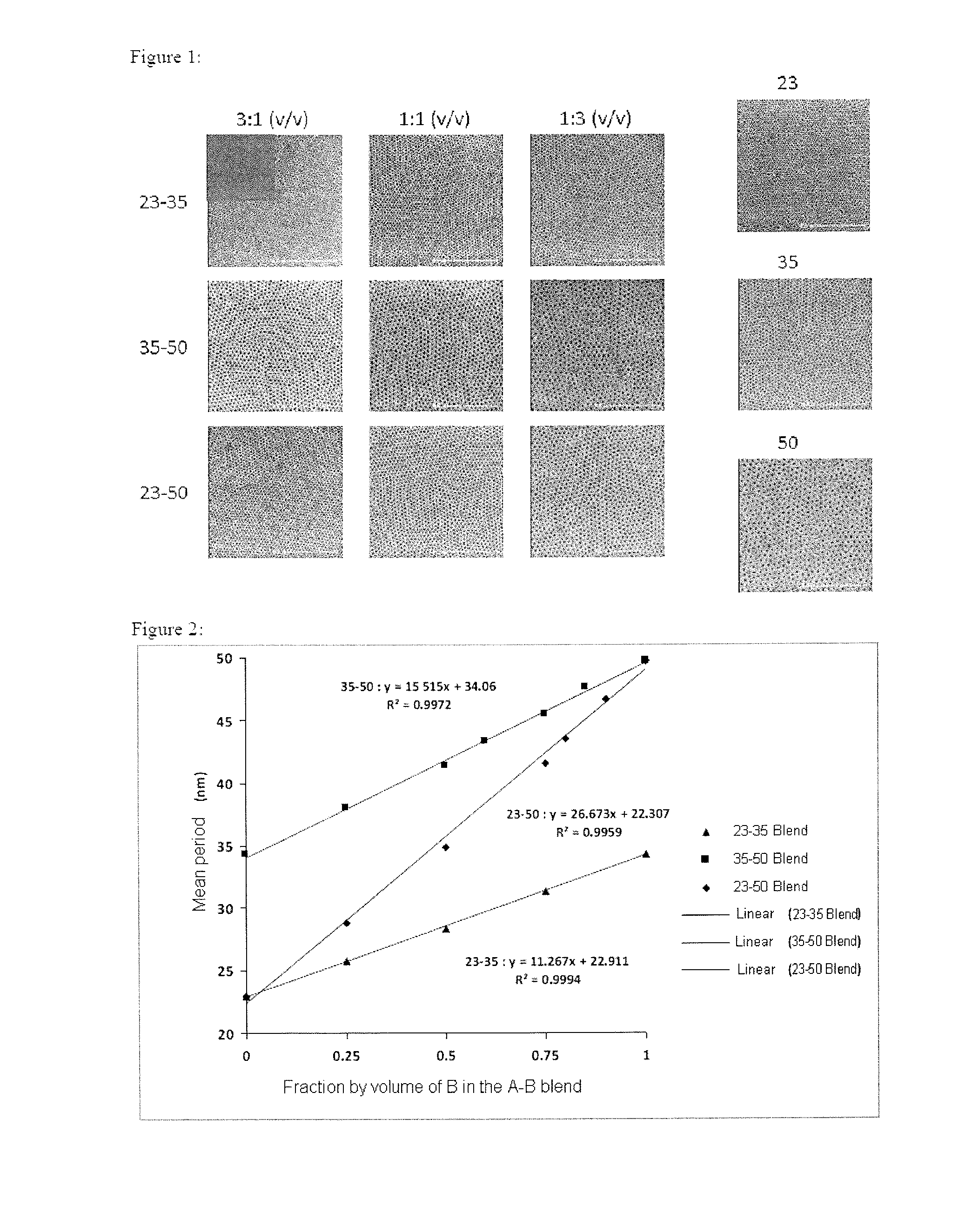Process for controlling the period of a nanostructured assemblage comprising a blend of block copolymers
- Summary
- Abstract
- Description
- Claims
- Application Information
AI Technical Summary
Benefits of technology
Problems solved by technology
Method used
Image
Examples
example 1
[0085]The following blends are prepared:
[0086]23-35 Blends: in the proportions 3:1, 1:1 and 1:3 (volume / volume).
[0087]35-50 Blends: in the proportions 3:1, 1:1 and 1:3 (volume / volume).
[0088]23-50 Blends: in the proportions 3:1, 1:1 and 1:3 (volume / volume).
[0089]The solutions of block copolymers alone (23, 35 and 50) will also be considered.
[0090]The solutions are deposited on a surface in the following way:
[0091]Preparation of the surface, grafting to SiO2:
[0092]Silicon wafers (crystallographic orientation {100}) are cut up manually into 3×4 cm pieces and cleaned by piranha treatment (H2SO4 / H2O2 2:1 (v:v)) for 15 minutes, then rinsed with deionized water and dried under a stream of nitrogen immediately before functionalization. The continuation of the procedure is that described by Mansky et al. (Science, 1997, 1458), with just one modification (the annealing is carried out under ambient atmosphere and not under vacuum). A random PS-r-PMMA copolymer with a molecular weight of 12,280...
example 2
[0103]In this example, the advantage is shown of using blends of block copolymers in comparison with the use of a single block copolymer. In addition to the possibility of finely adjusting the period, the blends of block copolymers allow the establishment of layers of block copolymers of high thickness without defect of orientation, compared with those observed when just one block copolymer is used for these same high thicknesses (typically >35 nm). For this, a blend of two block copolymers and a block copolymer, the period of which is equivalent (approximately 46-47 nm), are compared. The block copolymers 23 and 50, blended in proportions targeting a period of 46 nm, are compared with a sample C46 (46), the characteristics of which are as follows:
[0104]Nanostrength EO® C46:
[0105]Mn=85.7 kg / mol
[0106]Mw / Mn=1.16
[0107]PS / PMMA ratio by weight=69.9 / 30.1
[0108]Period: 46 nm
[0109]In FIG. 3, the 23-50 blend, compared with 46 alone, which are deposited on a surface prepared as in example 1, a...
example 3
[0111]In this example, the accuracy of the prediction of the period for blends of block copolymers deposited on a surface as carried out in example 1 is evaluated in comparison with the experimental measurement. There is found therein, in FIG. 4, for a maximum difference of 27 nm between the periods characterizing the morphologies of two block copolymers A and B, with respective periods of 23.05 nm for A and 49.7 nm for B, a difference of approximately 1.5 nm between the prediction and the measurement.
[0112]When A takes the value of 23.05 and B the value of 34.3, this difference is in the vicinity of 0.2 nm, which demonstrates the accuracy of the method which is a subject matter of the invention.
PUM
| Property | Measurement | Unit |
|---|---|---|
| Fraction | aaaaa | aaaaa |
| Fraction | aaaaa | aaaaa |
| Thickness | aaaaa | aaaaa |
Abstract
Description
Claims
Application Information
 Login to View More
Login to View More - R&D
- Intellectual Property
- Life Sciences
- Materials
- Tech Scout
- Unparalleled Data Quality
- Higher Quality Content
- 60% Fewer Hallucinations
Browse by: Latest US Patents, China's latest patents, Technical Efficacy Thesaurus, Application Domain, Technology Topic, Popular Technical Reports.
© 2025 PatSnap. All rights reserved.Legal|Privacy policy|Modern Slavery Act Transparency Statement|Sitemap|About US| Contact US: help@patsnap.com



